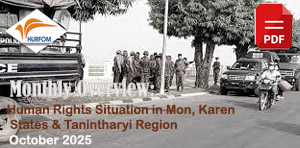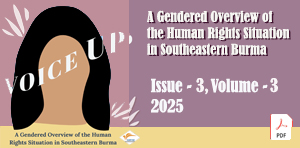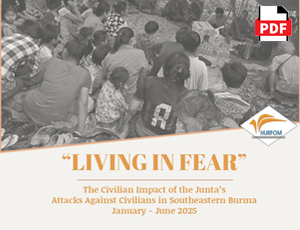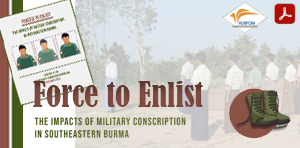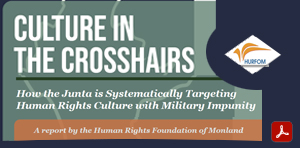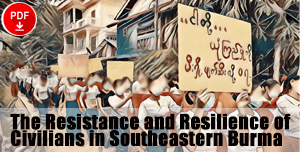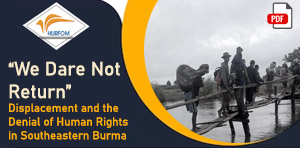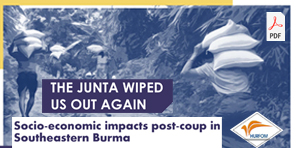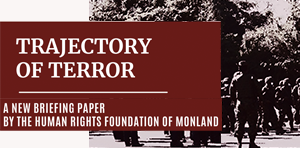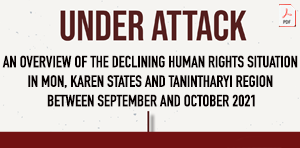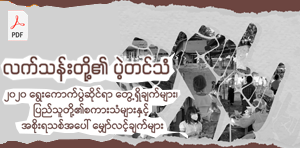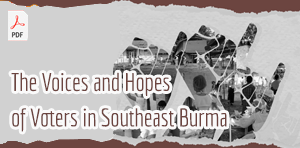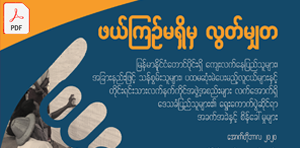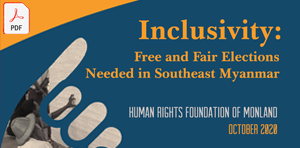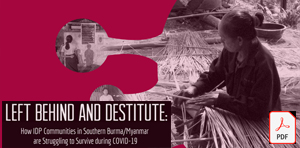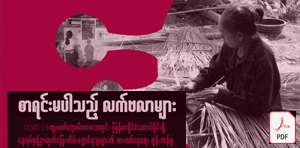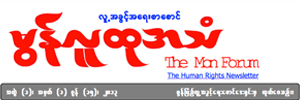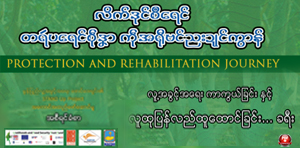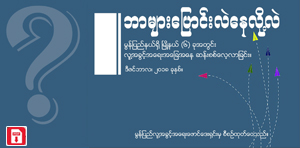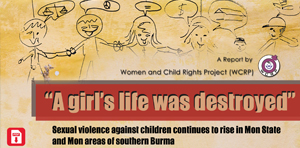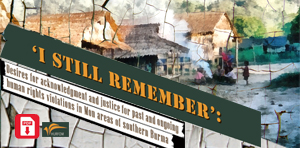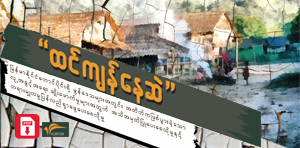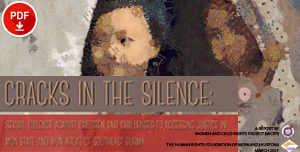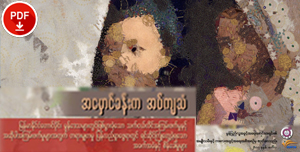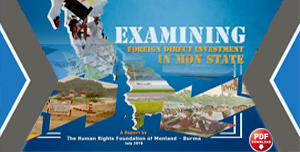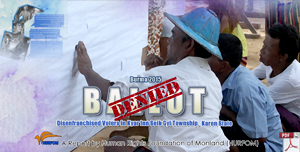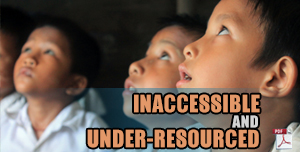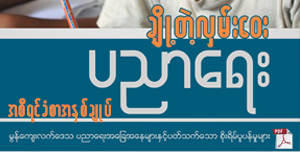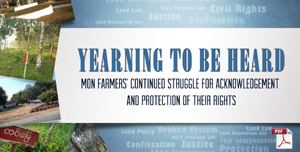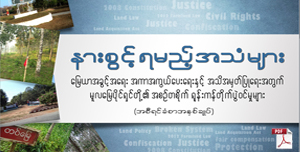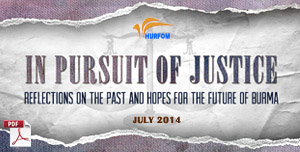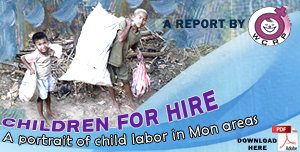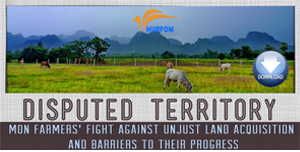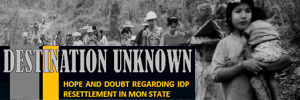Oil and Water: The Impact of Government salary increases on democratic prospects
March 8, 2010
Introduction:
In early January 2010, the Burmese government State Peace and Development Council (SPDC) announced a nationwide salary increase for all government employees. Under the announcement No. 104/2010, from the SPDC Department of Finance and Customs in Nayphidaw, the pay hike was implemented concurrent with the SPDC’s heavy-handed campaign to secure civilian support during the 2010 election. The pay hike raised the salary of all active members in the government workforce a flat 20,000 kyat per month, regardless of position or rank.![]() Download report as PDF [143 KB] Read more
Download report as PDF [143 KB] Read more
“We have to try”: Mounting pressure in election preparations and responses from the Mon State community
February 5, 2010
Introduction
Between December 2009 and early January 2010, South-East Command Major General That Naing Win issued a series of orders to local and regional Burmese government administrators in Mon State, mandating that their offices begin lobbying the residents of the areas under their administrative control for political support, in preparation for the 2010 election. These orders coincided with a rapid increase in human rights abuses targeting the citizens of Mon State.![]() Download report as PDF [176 KB] Read more
Download report as PDF [176 KB] Read more
Election preparations round off a year of abuses against farmers in Mon territory
January 3, 2010
Introduction:
As preparations by the Burmese State Peace and Development Council (SPDC) for the elections slated for 2010 mount, an increasing amount of pressure will be placed on already burdened rural agricultural communities in Mudon, Thanbyuzayat, Ye and Kyaikmayaw Townships. As previously noted in HURFOM’s October and November election reports, these preparations have targeted rural communities with the intention of securing political dominance in advance of the government’s announcement of the 2010 electoral rules. In taking farmers and community members from their time sensitive-cultivation and harvests of rice crops that are critical for community survival and economy, these preparations have place an excessive burden on agricultural populations.![]() Download report as PDF [ 328 KB] Read more
Download report as PDF [ 328 KB] Read more
Burmese government pressure on communities for support in 2010 election
December 1, 2009
Introduction:
While the Burmese government, the State Peace and Development Council (SPDC), has yet to release the election rules for the coming 2010 election, the SPDC has been proactive in preparations to secure its grip on power within a newly formed civilian government. The result has been a systematic effort by preexistent government controlled civilian groups and military forces, to create a climate untenable for the development of resistance or political thought separate from the SPDC party
line.![]() Download report as PDF [ 144 KB] Read more
Download report as PDF [ 144 KB] Read more
Report: Why Burmese Women Become Sex Workers
November 9, 2009
Introduction
“Think about it, nobody enjoys working as a prostitute.We have no money to survive… we have to work as prostitutes.” -Ma Thit Thit
This report examines some of the reasons why women from Mon State, Burma, become commercial sex workers. WCRP interviewed 11 prostitutes  from 10 brothels and restaurants who currently work in Ye Township and Thanbyuzayat Town. The majority of the interviewed women became prostitutes out of economic desperation and a lack of other job opportunities.
from 10 brothels and restaurants who currently work in Ye Township and Thanbyuzayat Town. The majority of the interviewed women became prostitutes out of economic desperation and a lack of other job opportunities.
Children in Burma are often expected to provide for their parents. Many of the women interviewed said that their parents were unable to support their families, due to a scarcity of jobs, a poor economy, and spending money on alcohol and illegal lottery tickets. Read more
“I am very tired”: Three months of abuses along the Kanbauk to Myaing Kalay gas pipeline in Northern Ye and Southern Thanbyuzayat Township, from August 2009 to October 2009
October 29, 2009
Introduction:
Much has been written on the human rights abuses leveled by the Burmese Army against the Karen and Mon villagers who live along the gas pipeline that runs through the Mon state from Kanbauk, in northern Ye Township, to Myaing Kalay, in the Southern Thanbyuzayat Township. In recent months, however, ongoing abuse inflicted by Burmese army battalions against the villagers has intensified. The presence of Burmese Army battalions in the area has plagued the villagers for more than 15 years. Since 1994, the State Peace and Development Council (SPDC) has deployed 20 army battalions in the area as a means of protecting the Yadana pipeline — the second natural gas pipeline that runs through the area — from rebel attacks. Various armed rebel groups exist in the area, including the KNU, the KNLA, and an unnamed, 30 –strong ragtag Mon splinter group.
![]() Download report as PDF [ 1.45 MB] Read more
Download report as PDF [ 1.45 MB] Read more
Empty Rice Baskets: An Analysis of the Causes and Implications of the August 2009 Flooding in Mon State
October 7, 2009
Introduction:
Once known as the ‘rice basket’ of Asia, Burma’s long-standing reputation as a leading rice exporter has dwindled as its economy has collapsed after years of rule by several generations of military juntas. Within the country, the leading role of rice as a food product and commercial cash crop has persisted. Yet despite its significant role in Burmese agriculture, the rice paddy farmers of Mon state, who have long been the backbone of rice production in Burma, are finding it increasingly difficult to continue to provide for their own livelihoods and those of their families.
The threat to paddy farmers is twofold, due to both man-made catastrophes as well as natural disasters. Due to the poor design and management of the Win-pha-non and Kataik dams, farms and villages throughout the area have been flooded as spillways running from the damn have failed. Thanks to excess rainfall, farmers in the 6 divisions of Mon State have lost hundreds of acres of rice paddies due to flooding. However, in addition to the destruction of their cash crops, paddy farmers face further loss of income and property from the abusive economic management practices of the Burmese government’s State Peace and Development Council’s (SPDC) agricultural programs. Despite flooding, seasonal limitations, and lack of funding, government administrators demand that farmers replant their crops to meet government rice quotas. While they are provided with no economic support, farmers are still expected to meet the quota or face the seizure of their land, and in some cases, forced manual labor.
![]() Download report as PDF [ 180KB]
Download report as PDF [ 180KB]
Background
Mon state is well known for its strong agricultural output and favorable climate. Because of its value as an agricultural region, Mon state is home to 7 dams. The 2 dams responsible for the widespread flooding that HURFOM has been documenting are the Win-pha-non and the Kataik dams. Both these dams, according to sources close to the SPDC, were built to contribute to the prevention of flooding and to assist local farmers in the cultivation of rainy season and summer paddy fields.
In August 2009 particularly intense seasonal rains fell. In response, government administrators released excess water from the Win-pha-non and Kataik dams. In addition to widespread flooding from the excessive monsoon rainfall, the release of dam water has proved catastrophic, as water has been spilling over the poorly designed dam’s runoff canals around the area. Read more
Harming the Young: Sexually Abused Children in Burma and the Migrant Communities of Thailand
October 3, 2009
WCRP:
Introduction
Burma’s military junta, the State Peace and Development Council (SPDC) is notorious for its oppression of the democratic opposition led by Daw Aung San Suu Kyi, and for human rights violations against ethnic nationalities who participate in liberation movements. In response to these violations and constant suppression, citizens are continually fleeing Burma. Read more
“Our Village Will Not Last:” Analysis of Abuses Conducted Against Civilians in Mon State and Tennaserim Division
September 7, 2009
INTRODUCTION
It is not easy to make any claim that Burma is a nation free of violence and armed conflict. However the Burmese military regime, the State Peace and Development Council (SPDC), often cites the successful brokering of 15 ceasefires with armed insurgent groups, who have been brought ‘back into the legal fold’ throughout the late 80’s and early 90’s, as proof that it has brought peace to Burma. These ceasefires have radically altered the landscape of the civil war in Burma by bringing the direct conflict with most of the ethnic armed groups to a close. However what has resulted is not peace, but a quieter violence, between smaller insurgent groups that did not sign ceasefires, and the Burmese army. This supposed peace has been characterized by continued violence and abuse conducted against civilians in parts of Karen State, Mon State, and Tennaserim Division who have been trapped between insurgent groups, and the Burmese policy of total destruction of its opposition. During August, the Human Rights Foundation of Monland-Burma (HURFOM) has focused its concern on the continuing abuses and serious human rights violations in Southern Burma and would like to highlight ongoing rights abuses faced by the local inhabitants and the consequences these have on the livelihoods of these residents. HURFOM field reporters have been documenting instances of forced relocation, land and property confiscation, arbitrary extortion and sexual violence through the testimonies of these individual victims, since March 2009.
![]() Download report as PDF [ 704KB]
Download report as PDF [ 704KB]

The Coming Crisis of Brigade No. 6: Analysis of the Current Abuses Committed Against the Karen Population
July 31, 2009
Introduction:
At the end of February 2009, the Karen Democratic Buddhist Army (DKBA) and State Peace Development Council (SPDC) joined forces in preparation for a campaign against the Karen National Union (KNU) territory to rout and destroy the Karen National Liberation Army (KNLA). The ensuing campaign has changing the face of regional politics, long dominated by the presence of the KNU and its armed wing the KNLA. With the loss of KNU Brigade No. 7, the KNU has been placed in an endgame position, preparing to defend the hart of its territory, Brigade No. 6, heavily populated with ethnic Karen. The fallout from Brigade No. 7’s defeat produced a tide of refuges who fled to locations along the Thai-Burma border, and the UNHCR administered refugee camps. They arrived bearing reports of abuses committed by SPDC and DKBA forces. As the joint SPDC and DKBA force positions itself to carry out their assault on Brigade No. 6, HURFOM focuses this months report on the on going human rights abuses in the southern Brigade No. 6 area, that will form a crisis broader and more terrible then that seen with the fall of Brigade No. 7.
![]() Download report as PDF [ 1.10MB]
Download report as PDF [ 1.10MB]



